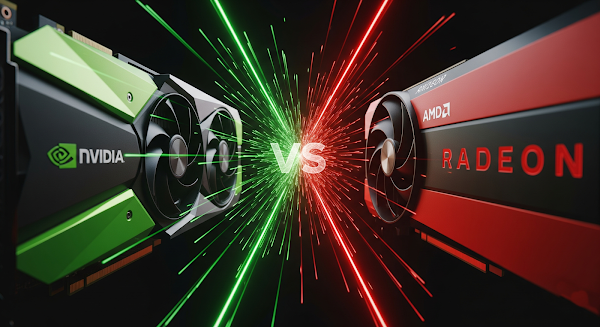🏆 NVIDIA vs. AMD: The Ultimate GPU Showdown for Late 2025 Gaming 🏆
The eternal question for every PC gamer is back with a vengeance: Team Green or Team Red? As we head into late 2025, the graphics card landscape has been redefined by a new generation of powerful hardware. NVIDIA is pushing its "Blackwell" architecture with the anticipated RTX 50-series, while AMD is firing back with its next-gen RDNA 4 GPUs. This isn't just a simple choice; it's a decision that will shape your entire gaming experience for years to come. This definitive guide will break down the fight for the top spot and help you choose the right GPU for your rig.
The Raw Power Battle: Rasterization and FPS Dominance
For gaming purists, raw performance in traditional (non-ray-traced) games is what matters most. In this arena, the battle is fiercer than ever. NVIDIA's flagship, likely the RTX 5090, continues to be a monster, pushing incredible frame rates for 4K high-refresh-rate gaming. However, AMD's strategy with RDNA 4 appears to be doubling down on what it does best: offering an incredibly strong competitor, like the rumored RX 8800 XT, that delivers jaw-dropping rasterization performance at a highly competitive price. If your primary goal is to max out settings in games like Call of Duty or Valorant, both camps offer fantastic options, but AMD often provides more frames per dollar.
The Ray Tracing and AI Kingdom: NVIDIA's Technological Moat
When the "RTX ON" switch is flipped, the story changes. NVIDIA has maintained a significant lead in ray tracing performance for several generations, and the Blackwell architecture widens that gap. Games with heavy path tracing, like Cyberpunk 2077, simply run better and look more visually stunning on NVIDIA hardware. This lead is supercharged by their AI upscaling technology, DLSS (Deep Learning Super Sampling). With features like Frame Generation and Ray Reconstruction, DLSS provides a superior image quality and performance uplift that AMD's FSR is still struggling to match perfectly. If you want the most cutting-edge visual experience, NVIDIA remains the undisputed king.
The Price-to-Performance Champion: AMD's Winning Strategy
AMD knows it has a tough fight in the features department, so it competes aggressively on price and accessibility. AMD's FidelityFX Super Resolution (FSR) is open-source, meaning it works on graphics cards from both AMD and NVIDIA, and even older models. This gives it a huge advantage in terms of adoption. Furthermore, AMD's RDNA 4 cards are expected to offer incredible efficiency and a lower power draw, which can save you money on both the GPU and your power supply unit (PSU). For gamers building a powerful mid-range gaming PC, AMD consistently delivers the most bang-for-your-buck.
The Verdict: Which Team Should You Join in Late 2025?
There is no single "best" choice for everyone. Your decision depends on your budget and what you value most.
- Choose NVIDIA if: You have a high budget and demand the absolute best in graphical technology. You want to experience ray tracing and path tracing at their peak performance, and you believe in the power of AI features like DLSS to drive the future of gaming visuals.
- Choose AMD if: Your priority is getting the maximum raw gaming performance for your money. You play a lot of esports or traditional rasterized games, value open-source technologies like FSR, and want to build a powerful and efficient gaming rig without paying the premium "NVIDIA tax."
Ultimately, both companies are pushing PC gaming forward. Carefully consider your favorite games, your monitor's resolution, and your wallet, and you'll be sure to make a winning choice.





